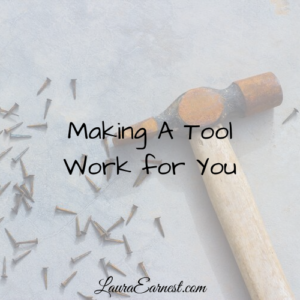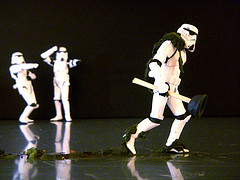
Making A Tool Work for You
Not all tools can be used optimally by all people. This applies whether it is a physical tool like a hammer or a productivity system. Today we will look at an approach to allow you to get as much out of a tool as you can.
I’ve always maintained that there is no magic bullet in productivity. The best we can do is assemble a toolbox of methods and systems and make them work for us. No one system is going to work for everyone in all circumstances. It’s a matter of how we use the tools to get things done.
The Hammer
Everyone is familiar with a hammer. But not everyone knows that there is an optimal way to use it.
At its basics, a hammer is a lever. The wrist acts as the fulcrum, the point on which the lever is pivoted. The longer the distance between your wrist and the head of the hammer, the more force you have to drive the nail.
That distance is directly linked to how well you use the hammer. Ideally, you would grasp the hammer handle near the end to multiply your force. If you hold it close to the head you won’t get as much force because the lever itself is much shorter.
You might be thinking, “why wouldn’t you use it at its optimal point? Why would you ever choose to move your hand up the handle?” It’s a good question, and it has to do with individual skills.
I don’t use hammers optimally, or even well. My hand-eye coordination is not great. If I hold the hammer where I am supposed to, near the end, and swing for a nail, chances are I will miss. But if I choke up (move up) on the hammer handle, I have a better probability of hitting the nail, even though it will take more swings to drive it home.
Is it better to have the optimal force, or take more swings? In this case, my objective is to get the nail driven in with the least amount of time. So I choke up on the hammer, knowing that it will take me more swings, but that the swings I do make will hit the nail and move me closer to my goal.
I will make more swings either way than someone who really can use a hammer. In my case, though, the position in which I hold the hammer (not optimal) means that my swings will be effective instead of missing the mark.
Not Optimal, But…
So how does this apply to productivity?
Productivity is all about effectiveness and efficiency. But it’s not an overall measurement taken against the population. It is individual effectiveness and efficiency. You have to take each system and adjust it so that it works best for you.
It’s not about meeting some mythical standard of optimal performance. Productivity is all about what works for you.
And some tools are just not going to work for you. I can’t use an axe (hand-eye thing again). The one time I tried, my instructor quickly decided that if I needed to cut up wood that a saw would be a much safer alternative. For everyone. Likewise, I can’t use Autofocus. Having an unending list of tasks that I work page by page paralyzes me to the point that I can’t do anything.
Making A Tool Work
That’s not to say that you can’t use tools even when they’re not a good fit. You just have to find ways to adjust how you use the tool to reach maximum effectiveness and efficiency for you.
Just like I choke up on the hammer, I adjust how I use the weekly review, first put forth in Getting Things Done. The contexts, multiple lists and insistence on letting projects slide don’t work for me. The weekly review does. But it works in the context of how I plan my weeks, not as described by David Allen. The end result is that I still have an idea of what my life will look like, but in terms of how I plan and perform my week.
So let’s take a look at how to make a tool work for you. I’ll do two examples: Mike Vardy’s day theming, and Flylady household management.
Day Theming
Day theming is when you take all of your tasks and slot them on the days assigned to that theme. For example, at home you could have a desk day, a cleaning day, an errand day, a gardening day, and so on. It’s a good way to group tasks according to where you perform them, making the whole process more efficient.
But let’s say that for the next three weeks you will be working at a remote office on Mondays, putting you home two hours later than you would normally be home. Monday was your errand day. You no longer get home in time to do the errands after work. What do you do? Or if your day is interrupted by a call from the school to get a sick child, you are not going to be able to stick to the schedule (unless your partner deals with all unexpected emergencies).
There are options here: move your themed days around to fit your current week schedule or build in days that are not themed in order to build in buffer for unexpected events.
Flylady Management
In Flylady’s system, you divide your house into 5 zones for deep cleaning, and you spend 15 minutes a day in that zone. With the 5 zones, you will completely clean your house every month, and never have to do spring or fall cleaning again.
But you look at your house and realize that you have more than five zones, or that if you divide into five zones you will have to spend more than the proscribed amount of time in order to get through the complete cleaning every month. Or maybe you realize it isn’t do-able, and sinks you back into doing nothing (which is exactly what the Flylady system is supposed to cure).
So you have a couple of options: aim to deep clean everything every quarter, stretching out the time for three months instead of one. Or maybe you divide your house into more than 5 zones, and rotate that way. Or you decide that not every task needs to be done every time you rotate through. All ways are a good way of modifying the system to make it work. It all depends on what works for you.
Conclusion
Just because we cannot use a tool efficiently without modification doesn’t mean we still can’t use it effectively. Adjust how you use the tool to get your advantage out of it, and you will find many more methods to get things done.
Photo by TRΛVELER . on Unsplash


